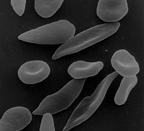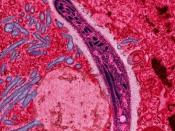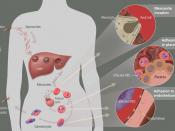Malaria is a parasitic disease characterized by fever, chills, and anemia. Malaria is caused by a parasite called Plasmodium that is transmitted from one human to another by the bite of infected Anopheles mosquitoes. In humans, the parasites migrate to the liver where they mature and release another form called merozoites. These enter the bloodstream and infect the red blood cells. The parasites multiply inside the red blood cells, which then rip apart within 48 to 72 hours, infecting more red blood cells. The first symptoms usually occur 10 days to 4 weeks after infection, though they can appear as early as 8 days or as long as a year later. Then the symptoms occur in cycles of 48 to 72 hours.
The majority of symptoms are caused by the massive release of merozoites into the bloodstream, the anemia resulting from the destruction of the red blood cells, and the problems caused by large amounts of free hemoglobin released into the circulation after red blood cells burst.
Sequential chills, fever, and sweating headache, nausea and vomiting, muscle pain, anemia. Malaria can also be transmitted congenitally, meaning from a mother to her unborn baby, and by blood transfusions. Headaches are usually painful and annoying. Nausea is the sensation leading to the urge to vomit. Anemia is a decrease in the ability of the red blood cells to provide adequate oxygen supplies to body tissues. These are Symptoms of Malaria.
The disease is a major health problem in much of the tropics and subtropics. Mosquitoes produce themselves near lakes, ditches, and swamps. They also like to situate themselves in long grasses. It presents the greatest disease hazard for travelers to warm climates. Mosquitoes in temperate climates can carry malaria, but the parasite disappears over the winter. These...



Well writen and Informative
This expositiry essay is quite well written and has a good amount of information in it which will inform the reader of "Malaria" and it causes + affects.
6 out of 6 people found this comment useful.